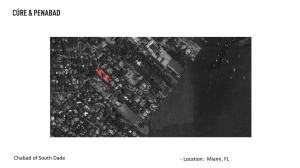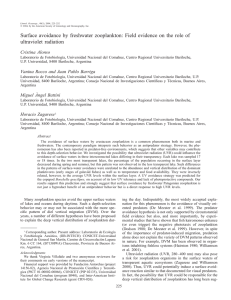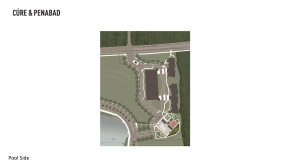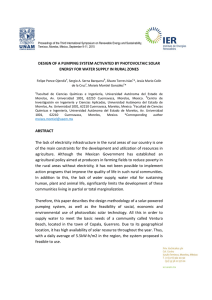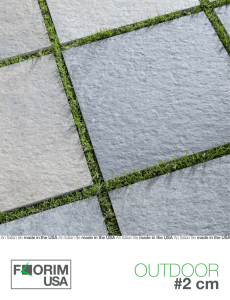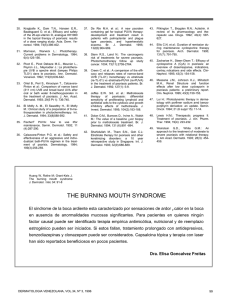peharda-2007-occupational skin diseases caused by-medri 1518-publishedversion-2ltmxc-s
Anuncio
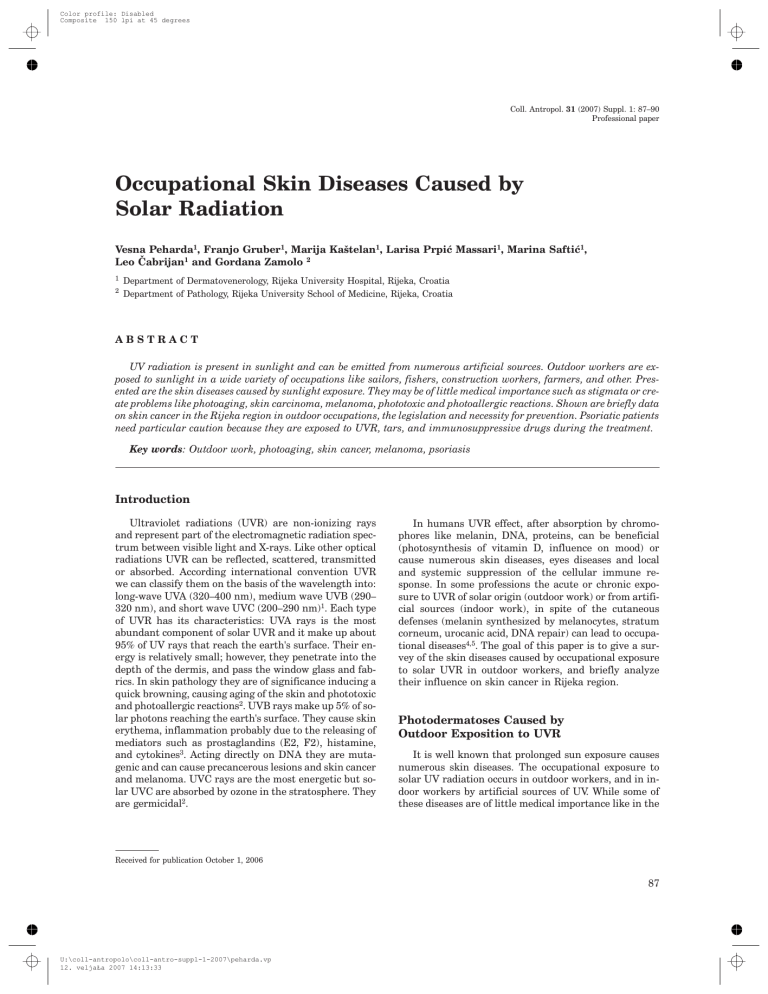
Color profile: Disabled
Composite 150 lpi at 45 degrees
Coll. Antropol. 31 (2007) Suppl. 1: 87–90
Professional paper
Occupational Skin Diseases Caused by
Solar Radiation
Vesna Peharda1, Franjo Gruber1, Marija Ka{telan1, Larisa Prpi} Massari1, Marina Safti}1,
Leo ^abrijan1 and Gordana Zamolo 2
1
2
Department of Dermatovenerology, Rijeka University Hospital, Rijeka, Croatia
Department of Pathology, Rijeka University School of Medicine, Rijeka, Croatia
ABSTRACT
UV radiation is present in sunlight and can be emitted from numerous artificial sources. Outdoor workers are exposed to sunlight in a wide variety of occupations like sailors, fishers, construction workers, farmers, and other. Presented are the skin diseases caused by sunlight exposure. They may be of little medical importance such as stigmata or create problems like photoaging, skin carcinoma, melanoma, phototoxic and photoallergic reactions. Shown are briefly data
on skin cancer in the Rijeka region in outdoor occupations, the legislation and necessity for prevention. Psoriatic patients
need particular caution because they are exposed to UVR, tars, and immunosuppressive drugs during the treatment.
Key words: Outdoor work, photoaging, skin cancer, melanoma, psoriasis
Introduction
Ultraviolet radiations (UVR) are non-ionizing rays
and represent part of the electromagnetic radiation spectrum between visible light and X-rays. Like other optical
radiations UVR can be reflected, scattered, transmitted
or absorbed. According international convention UVR
we can classify them on the basis of the wavelength into:
long-wave UVA (320–400 nm), medium wave UVB (290–
320 nm), and short wave UVC (200–290 nm)1. Each type
of UVR has its characteristics: UVA rays is the most
abundant component of solar UVR and it make up about
95% of UV rays that reach the earth's surface. Their energy is relatively small; however, they penetrate into the
depth of the dermis, and pass the window glass and fabrics. In skin pathology they are of significance inducing a
quick browning, causing aging of the skin and phototoxic
and photoallergic reactions2. UVB rays make up 5% of solar photons reaching the earth's surface. They cause skin
erythema, inflammation probably due to the releasing of
mediators such as prostaglandins (E2, F2), histamine,
and cytokines3. Acting directly on DNA they are mutagenic and can cause precancerous lesions and skin cancer
and melanoma. UVC rays are the most energetic but solar UVC are absorbed by ozone in the stratosphere. They
are germicidal2.
In humans UVR effect, after absorption by chromophores like melanin, DNA, proteins, can be beneficial
(photosynthesis of vitamin D, influence on mood) or
cause numerous skin diseases, eyes diseases and local
and systemic suppression of the cellular immune response. In some professions the acute or chronic exposure to UVR of solar origin (outdoor work) or from artificial sources (indoor work), in spite of the cutaneous
defenses (melanin synthesized by melanocytes, stratum
corneum, urocanic acid, DNA repair) can lead to occupational diseases4,5. The goal of this paper is to give a survey of the skin diseases caused by occupational exposure
to solar UVR in outdoor workers, and briefly analyze
their influence on skin cancer in Rijeka region.
Photodermatoses Caused by
Outdoor Exposition to UVR
It is well known that prolonged sun exposure causes
numerous skin diseases. The occupational exposure to
solar UV radiation occurs in outdoor workers, and in indoor workers by artificial sources of UV. While some of
these diseases are of little medical importance like in the
Received for publication October 1, 2006
87
U:\coll-antropolo\coll-antro-suppl-1-2007\peharda.vp
12. veljaŁa 2007 14:13:33
Color profile: Disabled
Composite 150 lpi at 45 degrees
V. Peharda et al.: Occupational Photodermatoses in Outdoor Workers, Coll. Antropol. 31 (2007) Suppl. 1: 87–90
case of pigmentations, telangiectasias or other stigmata,
which don't impair the working capacity, some others
cause serious concern6. The UVR can provoke skin alterations alone, or in combination with endogenous (porphyrins) or exogenous photosensitizing substances (furocumarins, cosmetics, dyes, tars oils)6,7.
Today, there is a concern regard the increase of UV radiation from solar origin resulting from depletion of the
atmosphere ozone8. The exposition to UV typically causes skin lesions in photoexposed areas: face, neck, décolleté, forearms, and the back of the hands. Prolonged
exposure to UV rays cause photoaging, actinic keratoses,
cheilitis actinica and more important malignant tumors
such as basal cell carcinoma, keratoacanthoma, squamous cell carcinoma, and melanoma9. About 5–10% of
the adult population is working outdoor in Europe9. In
these workers, especially with phototype I and II after
Fitzpatrick, the exposure to UV rays can cause solar dermatitis, actinic cheilitis, and with time also cutaneous
photoaging and skin tumors. Photoaging or extrinsic aging is characterized by the development of wrinkling,
deep furrows, yellow discoloration, coarness, irregular
pigmentation (lentigo actinica, guttate hypomelanosis),
telangiectasias in the sun exposed areas9. Sometimes,
translucent, dome shaped papule develop on the face
(psudomilium colloidale), or one can see brown-black
non-inflammatory papule and comedones periorbitaly (s.
Favre-Racouchot). Some studies found that 2.5% of agricultural workers presented these lesions, whilst they
were not present in a control group10. Most of these alterations are caused by UVA that generate reactive oxygen
species (ROS) and penetrate deeper in the skin causing
change not only in the epidermis (pigmentation) but
even in the dermis (degeneration of collagen and elastic
fibers)11. Studies in vivo in animal and humans have
demonstrated that exposure of the skin to UVR provoke
a decrease in pro colllagen-1 production and activation of
transcription factors (AP-1, NFkB) leading to an increase
of matrix metalloproteinases (MMPs), produced by keratinocytes and fibroblasts, like collagenase (MMP-1), gelatinase (MMP-3) and stromelysin (MMP-9), which results
in collagen degradation11. New studies by Berenburg and
al. demonstrate that in the photoaging after UVR exposure a role have also the damage of the mitochondrial
DNA induced by ROS, because it have a little repair
capacity12. In outdoor work frequently cause cancer in
sailors, fishermen, watermen, farmers, asphalters, building workers, and others6,9 (Table 1).
In some workers contact with plants or dyes can cause
phototoxic and photoallergic reactions. Phototoxic dermatitis (photophytodermatitis) is a non immunologic reaction which can develop in anybody given sufficient
phototoxic substance and sun exposure. They are common, characterized with erythema, blistering, pain, and
then long lasting pigmentation. Phototoxic dermatitis is
mostly caused by contact with plants that contain photosensitisers such as furocumarins. Furocumarins can be
linear i.e. psoralens (5-MOP, 8-MOP), or angular like
angelicin and pimpinellin. They bind to the nuclear DNA
88
U:\coll-antropolo\coll-antro-suppl-1-2007\peharda.vp
12. veljaŁa 2007 14:13:33
TABLE 1
OUTDOOR WORKERS POTENTIALLY EXPOSED TO
UV RADIATION
Fishermen
Farmers
Sailors
Gardeners
Watermen
Horticultural workers
Construction workers
Oilfield workers
Road workers
Pipeline workers
Brick masons
Military personnel
Postal carriers
Ski instructors
Policemen
Surfers
and cause cellular damage13. This can happen in florists,
horticulturists, gardeners, farmers, loggers, food handlers and others. The plants causing phototoxic reaction
are of the family apiaceae (formerly umbelliferae): celery
(Apium graveolens), false Bishop's weed (Ammi majus),
parsnip (Pastinaca sativa), parsley (Petroselinum crispum) cow parsnip (Heracleum sphondylium) that cause
trimmer dermatitis, angelica. Members of other families
of plants also can cause phototoxic reactions, so in the
family rutaceae – rue (Ruta graveolens) and citrus species, and among the leguminosae Myroxylon balsamum
and Psoralea corylifolia. Furthermore phototoxic reactions can induce figs (Ficus carica)14–17.
Interestingly celery infected with the fungus Sclerotina sclerotium contain more furocumarins and is more
harmful than the uninfected plant. Sometimes the use of
some drugs (diuretics, non-steroid anti inflammatory
drugs, phenotiazines) oils, tars can also induce sensitization to solar UVZ6,18.
Occupational Cancer in Outdoor Workers
The most serious long-term effect of exposure to natural or artificial UV light, particularly in light skinned,
poorly pigmented people, is the induction of precancerous lesions and malignant skin tumors. At the end of the
XIX century Unna associated the degenerative changes
in epidermis and dermis, found in the sun exposed area
of the skin, in sailors with the development of cancer19.
In the same time Enziere observed that cancer of the
lower lip was more common in peasants working outdoor
than in people of the town, and shortly thereafter Dubreilh stated precancerous keratoses and skin cancer occurred more commonly in outdoor workers20,21. Later it
was found that UVR induce mutation in the DNA of
cells, particularly on pyrimidine bases (thymine and cytosine) forming a four-membered cyclobutane ring or 6,4
photoproducts. There are C-T or CC-TT transitions.
Most of these DNA damage are quickly enzymatically
corrected (nucleotide excision repair)22,23. These mutations are present in suppressor genes such p53 or PTCH,
and if are not corrected, their product can't control the
cell cycle and favor the cells' growth, proliferation and
survival. Before 30 years Kripke and al. demonstrated in
Color profile: Disabled
Composite 150 lpi at 45 degrees
V. Peharda et al.: Occupational Photodermatoses in Outdoor Workers, Coll. Antropol. 31 (2007) Suppl. 1: 87–90
irradiated mice the importance of the immune response
in the carcinogenesis. So the clinical epidemiological data
of skin cancer were confirmed and the cellular and molecular mechanism of UVR carcinogenesis better understand24.
TABLE 2
SKIN CANCER AND OCCUPATION IN RIJEKA REGION
Mohar N. 1976
%
Sta{i} et al. 1998
%
Fishermen/Sailors
28.3
9.5
Other outdoor workers
18.7
11.8
Farmers
10.2
9.4
Housewives
35.4
11.8
7.5
56.9
Other
Epidemiologic studies assessed the relevance of UVR
in the development of basal cell cancer is related to cumulative sun exposure and also to intermittent exposure
(on the trunk), while squamous cell carcinoma is more
related to lifelong cumulative exposure. In the case of
melanoma it seems to be associated with intense intermittent UVR exposure, and is located often on the back
in males and on the lower legs in females25,9. Studies
from Australia and USA demonstrated the importance of
outdoor work for the development of basalioma, squamous skin cancer and melanoma; whilst data from Europe are contrasting4,25,26. So in Finland and Sweden,
there were no association of outdoor work in farmers,
forestry workers and construction workers and skin cancer. An explanation could be that in these countries the
cumulative exposure is relatively low27,28. Probably also
the different health systems and legislation in the European countries makes it difficult to compare the data26.
Recent studies in gardeners demonstrated the importance of sun exposure ours, the time of the day, natural
shade in the work place, and indoor breaks during peak
ambient UVR for the total UVR dose received29. In Croatia, studies by Jakac the pioneer in occupational dermatology, and by Mohar, demonstrated that skin cancers are
frequent in the Rijeka region in fishers, sailors, but also
in construction workers, ship workers and farmers30,31. It
was also found that the cancer developed mostly in fair
skinned worker. In more recent years the frequency of
skin cancer in fishers and sailors is dropping (see Table
2)32. This can be explained with the lower number of
workers in these professions, and they begin to work
later. Fisher work today mostly by night, and don't use
tars, and perhaps use sunscreens. The high number of
cancer in housewives can be explained by the fact they
frequently work outdoor in their vegetable gardens or
truck farms. Some reports outline the importance of sun
exposure as a health risk in professional cyclist, mountain guides, policemen33. So Moehrle et al. demonstrated
in mountain guides carrying dosimeters the day dose of
UV exceeded the limits 6 and more folds and this is suggestive for an increased risk of skin tumors33. It is not
easy to obtain the verification that the cancer is occupational because there is a long period between the exposure and its development. Particular caution need psoriatic patients because they are exposed to phototherapy
(UVB, PUVA, heliomarinetherapy) tars, and immunosuppressive drugs during the treatment, and so are at
high risk for development of cancer. In conclusion there
is a necessity to prevent the excessive exposure to sunlight in outdoor workers, because the exposure to solar
UVR can lead to various skin diseases. For this reason it
is to purpose legislation measure, educate the workers to
undertake adequate protection measures like wearing
appropriate clothing, hats, eye protectors, seek shade,
and use sunscreens.
REFERENCES
1. MAAT PJ, Dermatol Clin, 24 (2006) 1. — 2. GUARRERA M, G Ital
Dermatol Venereol, 136 (2001) 21. — 3. CLYSESDALE GI, DANDIE GM,
MULLER HK, Immunol Cell Biol, 79 (2001) 547. — 4. DIEPGEN TL, J
Dtsch Dermatol Ges, 3 (2005) 32. — 5. RAMIREZ CC, G FEDERMAN
DG, KIRSNER RS, Int J Dermatol, 44 (2005) 95. — 6. JAKAC D, Profesionalne dermatoze In: JAKAC D (Ed.): Dermatologija i venerologija.
(Med knjiga, Beograd-Zagreb, 1981) — 7. SKREB Y, SARI] M, Arh Hig
Rada Toksikol, 34 (1983) 275. — 8. SHAH N, Harvard Sci Rev, 121 (2003)
40. — 9. DIEPGEN TL, DREXLER H, Hautarzt, 55 (2004) 22. — 10. CELLINI A, OFFIDANI A, Dermatology, 189 (1994) 129. — 11 KRUTMANN J, Hautarzt, 54 (2003) 809. — 12. BERNEBURG M, KAMENISCH Y, KRUTMANN J, Photochem Photobiol Sci, 5 (2006) 190. — 13.
LEWIS WH, ELWIN- LEWIS MPF, Medical botany (Wiley, New York,
1977). — 14. MASO MJ, RUSZKOWSKI AM, BAUERLE J, DE LEO VA,
GASPARRO FP, Arch Dermatol, 127 (1991) 12. — 15. IPPEN H, Derm
Beruf Umwelt, 38 (1989) 190. — 16. MENEGHINI CL, ANGELINI G, Le
dermatiti da contatto (Lombardo, Roma, 1983). — 17. BERKLEY SF,
HIGHTOWER AW, BEIER RC, FLEMING DW, BROKOPP CD, BROME
CV, Ann Intern Med, 185 (1986) 351. — 18. KIEZ-SWIERCZYNSKA M,
KRECISZ B, Med Opl, 52 (2001) 383. — 19. UNNA P, Histopathologie der
Hautkrankheiten (Hirschwald, Berlin, 1894). — 20. ENZIERE JP, Du
cancer des levres (Thesis, Montpeller, 1894). — 21. DUBREUILH H, Ann
Derm Syph, 117 (1896) 1158. — 22. BENKERS R, BERENDS W, Biochim
Biophys Acta, 41 (1960) 550. — 23. SETLOW RB, CARRIER WL, J Mol
Biol, 17 (1966) 237. — 24. KRIPKE M, FISHER MS, J Natl Cancer Inst,
57 (1976) 211. — 25. ARMSTRONG BK, KRICKER A, J Photochem Photobiol B, 63 (2001) 8. — 26. DIEPGEN TL, Int Arch Occup Health, 76
(2003) 331. — 27. HANNUKSELA-SVAHN A, PUKKALA E, KARVONEN J, Arch Dermatol, 135 (1999) 781. — 28. PEREZ-GOMEZ B, POLLAN M, GUSTAVSSON P, PLATO N, ARAGONES N, LOPEZ- ABENTE
G, Occup Environ Med, 61 (2004) 117. — 29. THIEDEN E, COLLINS
SM, PHILIPSEN PA, MURPHY GM, WULF HC, Br J Dermatol, 153
(2005) 795. — 30. JAKAC D, Chron Derm, 2 (1971) 43 — 31. MOHAR N,
Acta Derm Iug, 3 (1976) 19. — 32. STA[I] A, LENKOVI] M, GRUBER F,
GRGUREV Z, In: PETRI N, ANDRI] D, ROPAC D (Ed.), 1. Kongres pomorske medicine. In Croat. (Split, 1998). — 33. MOEHRLE M, DENNENMOSER B, GARBE C, Int J Cancer, 103 (2003) 775.
89
U:\coll-antropolo\coll-antro-suppl-1-2007\peharda.vp
12. veljaŁa 2007 14:13:33
Color profile: Disabled
Composite 150 lpi at 45 degrees
V. Peharda et al.: Occupational Photodermatoses in Outdoor Workers, Coll. Antropol. 31 (2007) Suppl. 1: 87–90
F. Gruber
Department of Dermatovenerology, Rijeka University Hospital, Kre{imirova 42, 51000 Rijeka, Croatia
PROFESIONALNE BOLESTI KO@E PROUZROKOVANE SUN^EVIM ZRAKAMA
SA@ETAK
UV zrake nazo~ne su u sun~evom svjetlu {to dopire do zemlje, ali nastati mogu i iz brojnih umjetnih izvora. Radnici
razli~itih zanimanja kao {to su pomorci, ribari, gra|evinari, poljodjelci i drugi koji rade na otvorenom izlo`eni su UV
zrakama. Prikazane su bolesti i stanja koja mogu nastati uslijed djelovanja UV zraka na ko`u pri radu na otvorenom.
Ponekad to su nezna~ajne promjene kao stigmata, ali katkad mogu biti zna~ajne kao {to su fotostarenje, rak ko`e,
melanom, fototoksi~ne i fotoalergijske reakcije. Ukratko su iznijeti stariji i noviji podaci o raku ko`e po zanimanjima u
Rije~koj regiji, problemi legislature i potrebe prevencije. Posebnu pa`nju zaslu`uju bolesnici s psorijazom koji su jo{ vi{e
izlo`eni UV zrakama, katranima i imunosupresivima tijekom lije~enja.
90
U:\coll-antropolo\coll-antro-suppl-1-2007\peharda.vp
12. veljaŁa 2007 14:13:33
